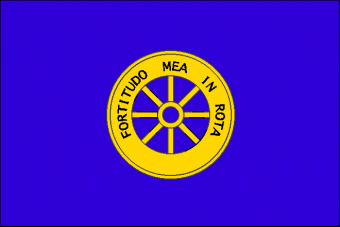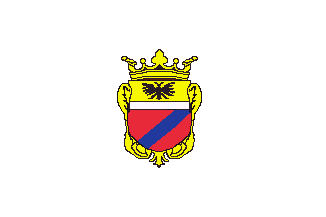
by Roberto Breschi from CISV

Last modified: 2004-12-28 by dov gutterman
Keywords: carrara | tuscany | toscana | modena | massa carrara | lucca |
Links: FOTW homepage |
search |
disclaimer and copyright |
write us |
mirrors

by Roberto Breschi from CISV
See also:
Other Sites:

by Jaume Ollé, 25 January 1996
Carrara is located in the Tuscany region. The flag of Carrara
is simple: white field with the shield.
Jaume Ollé, 25 January 1996
Carrara city was under the rule of the Ugolini family. After
the end of this family rule it was under the rule of the Cybo
family (princes of Massa 1568, dukes
of Massa and princes of Carrara 1664) and when Cybo family rule
ended,Carrara was transmited due to matrimony to Este Family (Modena rulers) 1741. Carrara was merged
in 1805 into the pincipality of Lucca,
but 1815 in Viena Congress was asigned (togheter with Massa) to
Modena.
Jaume Ollé, 10 October 1998
At J.W Norie - J.S. Hobbs: Flaggen aller seefahrenden
Nationen, 1971 [nor71] (original
print 1848):
196 Carrara - As above, except the blue is a wall of three layers
of bricks, and what's yellow on our page is in three different
colours: The chief is bright yellow, the crown is more orange
like, indicating gold I expect, and the ribbon/frame (?) is red
(and would merge with the gules field of the shield if it weren't
for the thin black lines).
Peter Hans van den Muijzenberg, 12 November 2001
I am History Ph.d and the man in charge in Taliercio School
Library of Liceo Scientifico Marconi in Carrara, Tuscany, Italy.I
am obliged to spoint out one mistake and also some eccentricity:
1. You write " ... Carrara city was under the rule of the
Ugolini family." (?!?) - Ugolini family ? I never read or
heard about any Ugolini family ruled in Carrara, not in history
and not in the historical list of ancient families !
Shortly: Carrara in 951 a.D. was a little but
important fortified borough, with its earl little fortess, under Obertus
I°, Earl of Luni and Marquis
of Eastern Liguria and also Earl of Palace of Roman
German Emperor Otto I°, but in 963 a.D. the
Emperor, fightning against Obertus, gave Carrara to Gotifred
I°, Bishop of Luni. There was about
one century of bishops' rule for Carrara, while the old earl
fortress became a property of Bobbio monastery and the old noble
family of Obertus divided itself into some branches of marquis,
the Este family, the Pallavicino, the Marquis of Gavi, the Massa
- Corsica family (ruled on Massa, Tuscany, also), the Brunswick
and Marquis Malaspina family (ruled from Tortona
and Voghera to Lunigiana and Bosa, Sardinia). There were ages of
wars beetwen Luni Bishops and Malaspina Marquis, while in Carrara
was growing the town municipality, totally free in 1253,
and, above all, some biggest Powers started to put under
control Carrara and its white marble quarries !
1187 Rainieirus, Abbot of Bobbio, assigned the
old city castle, the "Rocha de Cararia", to the sons of
Marquis Obicius Malaspina I° the Great .
1215 Carrara was under Guglielmus Marquis of
Massa - Corsica.
1232 The Earl - Bishops of Luni again !
1265 Lord of Carrara was Enzus, son of the
Emperor Fredericus II°.
1273 the Earl - Bishops of Luni again, with
Enricus de Fucecchius.
1313 - 1322 Emperor Arrigus VII° stripped of all feudal
authority the Earl - Bishops of Luni and assigned Carrara to the
Republic of Pisa.
1322 - 1328 The warlord of
Lucca, Castruccio Castracani, took Carrara.
1329 one Malaspina again, Marquis Spinetta the
Great from Fivizzano.
1343 - 1404 Carrara was under the rule of Visconti
family, the Dukes of Milan.
1404 - 1436 Paolo Guinigi, Lord of Lucca ruled on
Carrara.
1437 - 1446 The Visconti from Milan again.
1448 - 1472 Carra had an own local prince, Spinetta di
Campo Fregoso, who transformed the old castle in a beautiful
little royal palace (today Fine Art Academy of Carrara !).
1473 Jacopo Malaspina, Marquis
of Massa became the new lord of Carrara also, and the two
neighbouring cities formed the little state of Malaspina, from 1519
linked with Cybo family and then with Maria
Teresa Cybo Malaspina linked with Este family,
the Duke of Modena. The last local lord of Massa and Carrara was
until 1824, Maria Beatrice Cybo Malaspina Este.
2. From middle age the only flag of Carrara was its gonfalone:
the old gold wheel, with the Latin motto "Fortitudo
mea in rota", the flag you show maybe was a
gonfalone of Malaspina of Massa (without the spicked mace), sure
something linked like Marquis Malaspina with Roman German Empire
as the blackeagle tell us.
Renato Vita, 26 March
2002
Information you refer has origin in me, and is was taken from
Hispano Americana Enciclopaedya that say in Volume 11 page 1294:
"Del siglo XIII data la fundacion de la iglesia de San
Andres, atribuida al celebre arquitecto pisano Andrea Ugolino. La
casa de este dominó en Carrara durante bastante tiempo siendo
sustituida por la de los Cybo..." (from the XIII century is
the creation of the Church of St Andrew, attribued to famous
architect from Pisa, Andrea Ugolino. The House of this dominated
Carrara for enough time, and was substitued by the House of
Cybo).
Jaume Ollé, 27 March 2002
I wish to add some comments to Renato Vita's message
about Carrara flag, since he is raising some important points to
keep in mind when dealing with Italian vexillological matters.
He is right and he is wrong when he states "From middle age
the only flag of Carrara was its gonfalone: the old gold wheel,
with the Latin motto "Fortitudo mea in rota", the flag
you show maybe was a gonfalone of Malaspina of Massa (without the
spicked mace), sure something linked like Marquis Malaspina with
Roman German Empire as the blackeagle tell us."
Actually, what he is saying here is true, since in Italy the
gonfalon only has an official status, requiring a President's
decree (for Carrara: August 1st, 1972. Its origin are a lot
older, though!), while the civic flags need a simple decision
from the city masterhood. Going back to ancient times the
possible configurations of civic flags were rather complex: the
gonfalone was a sacred standard for most of the Italian
communities, however it had to compete against Lords'banners,
organisations' and parties'flags and Church insignia for the
predominance. Things changed drammatically when the merchant
traffics on sea started to flourish in the Mediterranean area and
the European Atlantic routes. At this point Vita is wrong:
Carrara had flags to distinguish her on the seas, as every town
owning a merchant fleet. These flags did not compete against the
gonfalone, which remained (and remains) a ground-based symbol,
and appeared on a number of flag charts and vexillological
sources at least from the XVII century on. The Dukedom of Massa
and Principality of Carrara had maritime ensigns: two of their
images are preserved for example in one of the documents at the
State Archive of Massa and date to 1670 and 1684. They are white
and display two different models of Alberico II's coat of arms at
the center. They are still referred to in a letter of 1830 to the
Duke of Modena, then ruler of the area, a letter now available at
the State Archive of Modena. It is important to note that we are
not presenting a flag of the city of Carrara, but the ensign to
be used on the ships of that town (and the others running patents
granted by the government of Massa and Carrara). White ensigns
with State arms remained in use till 1796, when the French troops
invaded the territory and shortly after joined the old state to
the newly constituted Repubblica Cispadana. Massa and Carrara
then followed the events of the Napoleonic republics in Northern
Italy to 1815. At that point no fleet survived and the white
flags flew on the coastal fortresses only. It took some years
before ships were again flying an ensign, yet a different one:
that of the Estense Dukedom (the red white red horizontal
tricolour with a blue / white / blue pale). In 1848 Massa and
Carrara merged into the Grand-Duchy of Tuscany, using her
tricolour until 1849, when they were re-assigned to Modena.
Finally, in 1859 the Duke's troops left the territory and a
provisional government raised the Italian tricolour with the
Savoy shield. There are many references for "Carrara"
ensigns, among which I found of best help:
[sig12] Die Flagge, R. Siegel
(Vize-Admiral), Dietrich Reimer, Berlin, 1912; [aai] Le bandiere degli Stati italiani,
5) Gli Stati della Toscana, A) Massa e Carrara, Aldo Ziggioto, in
Armi Antiche - Numero speciale per il 4° Congresso
Internazionale di Vessillologia, Accademia di s.Marciano, Torino,
1971 (Proceedings of the fourth International congress of
Vexillology, Turin, 24-27 June 1971); La Marina di Avenza tra
Vele e Bandiere, Pietro di Pierro, Aldus, Carrara, 1997 (a book
not included in FOTW's bibliography: a very valuable source of
information for Massa and Carrara ensigns, language: Italian,
pages: 73 + 7 colour tables, no ISBN, format: 15x21 cm
(basexspine)).
Pier Paolo Lugli, 15 April 2002

by Bruno Fracasso, 4 January 2001
It is impossible that the flag of Carrara is that shown above.
In fact here is the gonfalon and it hasn't got the above coat of
arms in the center.
Bruno Fracasso, 4 January 2001
From <www.radicedidue.com>:
"GONFALONE - Drappo d'azzurro riccamente ornato di
ricami d'oro e caricato dello stemma comunale con l'iscrizione
centrata in oro: «Città di Carrara» (Decreto del Presidente
della Repubblica in data 1 agosto 1972).
Un bassorilievo sulla facciate della casa ora detta Repetti,
antica sede del comune, risalente al XIII secolo, è ritenuto una
delle prime raffigurazioni dello stemma di Carrara. Il suo
simbolo è la ruota, da sempre emblema del lavoro dei suoi
abitanti. Sulle ruote è stato trasportato il marmo dalle cave
delle montagne agli approdi del mare. Un'altra interpretazione
vuole che la ruota alluda all'antico termine germanico Rode, da
cui «la ruota» o «alla ruota», che anticamente indicava i
terreni che si iniziavano a dissodare. Successivamente, proprio
su di essi si sviluppò la città. Non risultano notizie su
quando Carrara fu dichiarata «Città». Probabilmente essa fu
considerata tale sin da quando il territorio della sua comunità
fu elevato a marchesato dall'imperatore Massimiliano II, il 23
agosto 1568. Il titolo di marcbesato è confermato dalla corona
posta sopra lo stemma, concessa con regio decreto in data 10
dicembre 1942 e confermata dal Presidente del Consiglio dei
ministri in data 6 febbraio 1969. Quello di città è
implicitamente confermato dai decreti sopra citati. "
Dov Gutterman, 30 July 2002